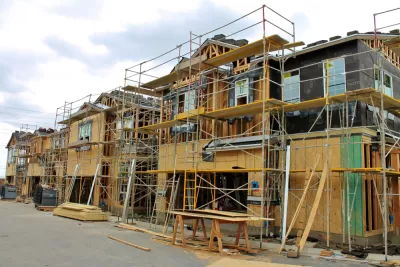A leading scholar of state and local government argues that local governments’ need to regulate business should take priority over the state and national interests in lowering housing costs. Are his assumptions persuasive?

When I was arguing about housing policy on a listserv, one of my fellow participants cited an article by Richard Schragger of the University of Virginia’s law school. Schragger’s article criticizes attempts by state legislators to preempt local zoning policy.
While I’ve read (and critiqued) plenty of anti-housing articles, Schragger's article is unusual because it goes beyond the usual supply skeptic arguments and defends local control for reasons unrelated to housing costs. Because Schragger is one of our nation's leading authorities on local government issues, I expected to be intrigued by Professor Schragger’s argument — but I wasn’t persuaded. It seems to me that Schragger's arguments rest on a variety of questionable assumptions:
1. “We Have to Save Zoning To Save Local Control Over Everything Else.” Schragger admits that “certain kinds of local land use restrictions are pernicious” but that “Skepticism of localism in the land-use arena easily morphs into state dominance across all fields.” In other words, if states have too much control over land use law, they will limit local government in not-so-good ways as well.
But as Schragger admits in the very next paragraph, state legislatures are already “keen to preempt local laws across large swaths of public policy.” It logically follows that local control over zoning won’t prevent states from micromanaging their cities. Schragger focuses on conservative state governments’ attempts to restrict left-leaning local policies. But as I have written elsewhere, blue state governments micromanage their cities as well; New York City’s ability to reform itself is limited in a wide variety of ways by state government. (For example, the state has imposed a floor area ratio cap that limits housing construction in the city). In other words, states will micromanage local governments even if they leave zoning untouched.
More specifically, Schragger argues that local governments should have unlimited land use power to extract concessions from businesses. For example, Schragger cites numerous examples of “the deployment of the land use permitting process to hold specific developers or incoming industries to higher wage and labor standards.” In other words, if groups favored by progressives (like unions) can get veto power over development and slow construction to a crawl, that’s actually a good thing because a few workers might get pay raises, or an environmental group can get a few policy concessions. But this does not seem like a particularly egalitarian result to me: Schragger admits that high-cost cities like New York tend to be among the most unequal cities in the U.S. (p. 188)- and when the middle class is priced out of these cities, those cities become even more unequal.
2. “We’ve Tried Statewide Land Reform And It Hasn’t Worked.” Schragger mentions that “In California and Oregon, state-level land-use regimes have been in place since the mid-to-late 1970s” (p. 152), yet those states are more expensive than most. But zoning reform in Oregon was focused more on limiting supply rather than increasing it; Oregon’s urban growth boundaries were designed to protect the state’s rural areas from suburban development, not to increase housing supply. Similarly, the California Coastal Commission exists to keep development away from California’s beaches, not to expand housing supply. In other words, 20th-century zoning reform was not designed to reduce housing costs, so to complain that it didn’t reduce housing costs isn't really relevant to whether a more deregulatory approach would have different results.
3. “Permissive Zoning Hasn’t Prevented Bad Stuff Unrelated To Housing Costs.” Schragger notes that in Houston, a city that has allowed more housing than most higher-cost cities, the “lack of zoning… has not benefited low-income communities, who have no effective means to protect themselves from the discriminatory siting of undesirable land uses.” The cheapest apartments in Houston, according to Zillow, rent for as little as $450. Don’t low-income people benefit from this?
4. “Even If Less Zoning Reduces Housing Costs, We Should Only Care About Poor People Who Never, Ever Move.” Schragger expresses “concerns that state-level land use reform will mostly redound to the benefit of investors and developers and not to those residents with limited resources who seek to afford to remain in place” (p. 129) (emphasis mine)- implying that residents with limited resources are only interested in “remaining in place” rather than moving to inexpensive housing. He adds that even though people “in the market for housing… are often priced out of high-cost urban markets” (emphasis mine), reformers “should be careful not to equate their interests with those of the working-class and especially minority poor” (id.), implying that working-class people aren’t "in the market for housing" or priced out of New York or San Francisco. Maybe I misunderstand Prof. Schragger here, but these passages sound to me like a suggestion that yuppies move around and benefit from lower rents, but poor people don’t move at all and don’t really need a low-cost housing market as long as they have rent control or public housing.
But in fact, it is simply not the case that poverty equals stability. As Schragger himself writes a few pages later, "housing instability is an almost permanent state of affairs for a significant portion of urban residents." Census data show that lower-income households tend to move more than other Americans. This is common sense: if your income is low and unstable, you are more likely to be unable to pay rent than if you can afford to save. And at a time when American cities are struggling to house a tide of asylum applicants, the idea that poverty equals immobility is even more disconnected from reality than it was in 2021 when Schragger wrote this article. And if poor people move around a lot, it logically follows that they benefit from lower rents.
Even if government came up with enough money to house everyone who was truly poor, a housing policy that disregards middle-class interests would not be ideal. Suppose that a city has a housing market is divided between subsidized housing for the poor and a stagnant housing supply for the nonpoor. In such a city, the rich can afford high costs while the middle class gets priced out, thus creating a two-class city: hardly a result that progressives concerned about inequality should support.
5. “Zoning Doesn’t Matter Because It Reflects What Consumers Want.” Schragger notes that when Minneapolis allowed more triplexes, only three triplexes had been built. He therefore concludes that “existing zoning laws reflect consumer demand.” (p. 173). This seems like a bit of an overgeneralization. Sunbelt cities have generally allowed more housing in recent decades than high-cost cities like New York or San Francisco; does Schragger really think that this reflects lower demand for housing in San Francisco?
Schragger also throws in a few “supply skeptic” arguments; however, most of these seem to have been endlessly debated elsewhere (including in some of my own Planetizen posts). For example, Schragger writes that “market-oriented reforms- which tend to increase land values- can lead to higher, not lower prices.” But as I have pointed out elsewhere, land values have risen both in cities that add lots of housing and in cities that don’t add lots of housing, so I’m not sure there is a causal connection. Similarly, Schragger expresses concern that “the construction of mostly unoccupied housing in high-demand cities does little to increase the supply of affordable housing.” But Schragger’s own footnote on that page claims that only 4000 "ghost apartments" exist in New York City — a tiny amount in a city with 8 million people. (And as I have pointed out elsewhere, other data support the claim that consistently unoccupied apartments are rare). Schragger writes that increasing housing supply in a place with amenities “will only increase the population of amenity-seekers.” But as I have written elsewhere, the “induced demand” theory makes no sense. As I have written elsewhere, if more housing led to more demand, the places that allowed the most housing would have the most demand, and the highest housing costs.

Trump Administration Could Effectively End Housing Voucher Program
Federal officials are eyeing major cuts to the Section 8 program that helps millions of low-income households pay rent.

Planetizen Federal Action Tracker
A weekly monitor of how Trump’s orders and actions are impacting planners and planning in America.

Ken Jennings Launches Transit Web Series
The Jeopardy champ wants you to ride public transit.

Rebuilding Smarter: How LA County Is Guiding Fire-Ravaged Communities Toward Resilience
Los Angeles County is leading a coordinated effort to help fire-impacted communities rebuild with resilience by providing recovery resources, promoting fire-wise design, and aligning reconstruction with broader sustainability and climate goals.

When Borders Blur: Regional Collaboration in Action
As regional challenges outgrow city boundaries, “When Borders Blur” explores how cross-jurisdictional collaboration can drive smarter, more resilient urban planning, sharing real-world lessons from thriving partnerships across North America.

Philadelphia Is Expanding its Network of Roundabouts
Roundabouts are widely shown to decrease traffic speed, reduce congestion, and improve efficiency.
Urban Design for Planners 1: Software Tools
This six-course series explores essential urban design concepts using open source software and equips planners with the tools they need to participate fully in the urban design process.
Planning for Universal Design
Learn the tools for implementing Universal Design in planning regulations.
Ada County Highway District
Clanton & Associates, Inc.
Jessamine County Fiscal Court
Institute for Housing and Urban Development Studies (IHS)
City of Grandview
Harvard GSD Executive Education
Toledo-Lucas County Plan Commissions
Salt Lake City
NYU Wagner Graduate School of Public Service






























